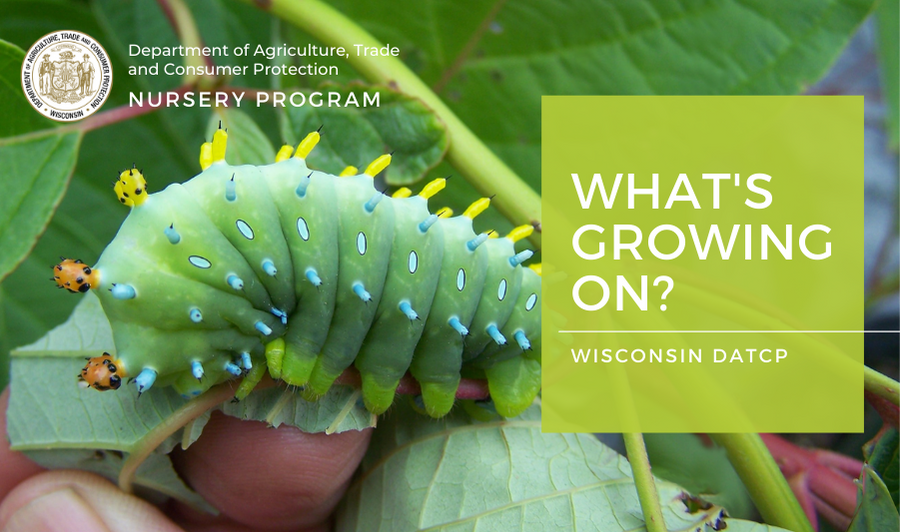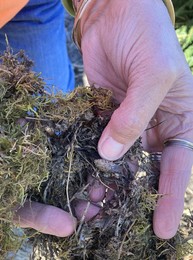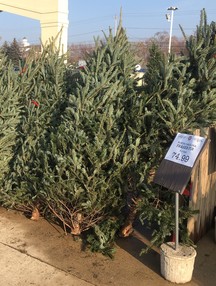|
 _____________________________________
Dear Wisconsin nurseries, Christmas tree growers, and gardeners:
Simple base 50 growing degree day accumulations as of November 13th were 1864 in Bayfield, 1971in Medford, 2194 in Wausau, 2466 in Hancock, 2709 in Green Bay, 2892 in Racine, 2881 in Madison and 2907 in La Crosse. Hopefully you were able to take full advantage of the extended pleasant fall weather.
Take a moment now to read through a few updates from the DATCP nursery program and send any feedback, questions, or ideas for future e-news updates to datcpnursery@wisconsin.gov.
Having trouble viewing this email? View it as a Web page.
_____________________________________
|
|
 DATCP staff inspecting Pennsylvania nursery stock for SLF | DATCP C. Foelker

On November 3, 2022, DATCP received a report from a Walworth County landowner that had found multiple dead and a single dying adult spotted lanternfly on nursery stock purchased from an Illinois nursery. The stock originated in Pennsylvania and had been shipped to the Illinois nursery on October 20, 2022.
The landowner had learned about spotted lanternfly (SLF) from his arborist and knew it was an invasive insect not yet found in Wisconsin that needed to be reported right away.
On November 7, 2022, staff from DATCP and USDA-APHIS-PPQ conducted a follow up inspection at the property where the landowner was installing the stock. Seven dead adults were found in the branches of recently planted Norway spruce trees. No egg masses were found. The site will be a high priority site for visual survey and trapping next summer.
The Pennsylvania nursery that shipped the stock is under an SLF compliance agreement and had treated the material prior to shipping. However, it was still alarming to find so many dead adults on the stock and is a good reminder to always inspect your stock upon arrival in the nursery trade and prior to planting in your yard.
|
_____________________________________
|
|
|
Renew your nursery license online using the MyDATCP Portal | DATCP image
Nursery and Christmas tree licenses for this growing season (LY2023) will expire on February 20, 2023. Expiration notices to renew your license for the next growing season (LY2024) were emailed out to current license holders the week of November 7, 2022. Paper notices will mailed out at the end of the month. Please contact us if your email or address has changed since your last renewal.
License renewals can be completed online by using the MyDATCP portal. If you have never used the online license portal, a PIN will be located on your expiration notice so you can register for a MyDATCP account. If you need assistance getting into your account, contact datcpnursery@wisconsin.gov or (608) 224-4574.
Renewing online is an efficient way to update location information, contact information, and sources of plant materials without having to mail in a paper application. A new feature this season is the ability to print your license certificate from your computer after you renew online. No need to wait for the mail.
If you are no longer in business, please let us know so we can close your license. This avoids any enforcement actions, which may occur for entities who fail to contact us or renew by the February 20, 2023 deadline.
Tips and Reminders:
- Allow pop-ups from MyDATCP.
- Only one tab of MyDATCP can be open at a time.
- If you have multiple license types, they each need to be renewed individually. However, you can pay for them all at once by accessing your invoices from the "My Invoices" tab of MyDATCP.
- Watch the short video tutorial to walk you through the online renewal process.
For more information, email DATCPnursery@wi.gov, call (608) 224-4574, or visit the Nursery and Christmas tree licensing webpage.
_____________________________________
|
|

Did you know Wisconsin has a Landscape Registry?
Registrant Information:
The Landscape Registry allows Wisconsin residents to be notified 12 hours prior to a commercial pesticide application to neighboring landscape (turf, ornamental, or mulched area). To be on the registry, you must apply by paper application or online between November 1, 2022 and February 1, 2023. Reapplication to the registry is required for reach season. Once registered, lawn care companies can notify you when treating a property you listed. Properties can only be registered if they are located on the block where you live or blocks that are immediately adjacent to the block where you live.
This is NOT available for plain fertilizer applications or pesticide applications to:
- Properties beyond your block or adjacent blocks
- Farm fields or other agricultural productions
- Buildings
- Utility or transportation right of ways
Business Information:
On March 15, 2023, the Landscape Registry list goes live on DATCP's website. Once the list is published, there are no revisions made to it. If the customers’ addresses are on the list, you will need to contact the registrants who asked to be notified 12 hours prior to the landscape application. Landscape applications include spraying for mosquitos and turf and ornamental applications.
The advance notice must include ALL of the following:
- The address to be treated
- The scheduled application date
- The name, address, and telephone number of the business making the application
- The pesticides that may be used (brand name, product name, or common chemical name)
If you have any questions about the landscape registry or requirements, visit DATCP's website or email datcplandscaperegistry@wi.gov
|
_____________________________________
|
|

Inspectors will begin conducting Christmas tree lot inspections starting in mid-November. The purpose of lot inspections is to verify that growers of Christmas trees from Wisconsin have a Christmas tree grower's license with DATCP and material brought into the state does not have any regulatory pests or diseases. Christmas tree growers that grow and sell more than $250 in Christmas trees, wholesale or retail, are required to have a Christmas tree license. For more information, visit DATCP's Website. In 2022, 378 Christmas tree grower licenses were issued to Wisconsin growers.
In previous years, inspectors have intercepted cut trees and décor infested with invasive pests hitching a ride into Wisconsin from other states. For example, the non-native, invasive pest known as the elongate hemlock scale (EHS) has been found multiple times on fir wreaths, Christmas trees, baskets, and boughs from eastern states. Since EHS is a threat to Wisconsin’s Christmas trees, native hemlock, and balsam fir forests, a quarantine rule has been proposed to prevent this pest from establishing in Wisconsin. We have also occasionally detected boxwood blight fungus and invasive bittersweet on wreaths, spongy moth egg masses on cut conifers, and dead spotted lanternfly adults on conifer nursery stock. Growers or wreath makers that bring in boughs from out of state should inspect material thoroughly before use. A Pest Abatement Order, requiring items to be removed from sale and destroyed may be issued for Christmas trees, wreaths and decorative material found at retail locations infested with live invasive pests or diseases.
|
_____________________________________
|
|
|
Farmers rely on crop insurance to protect themselves from disasters and unforeseen events, but not all crops are insurable through the USDA’s Risk Management Agency. The USDA Farm Service Agency’s (FSA) Noninsured Crop Disaster Assistance Program (NAP) provides producers another option to obtain coverage. NAP provides financial assistance to producers of non-insured crops impacted by natural disasters that result in lower yields, crop losses, or prevents planting.
Commercially produced crops and agricultural commodities for which crop insurance is not available are generally eligible for NAP. Eligible crops include those grown for food, fiber, livestock consumption, biofuel or biobased products, or be commodities such as value loss crops like Christmas trees and ornamental nursery, honey, maple sap, and many others. Eligible causes of loss include drought, freeze, hail, excessive moisture, excessive wind or hurricanes, earthquake, flood.
Interested producers must apply for coverage using FSA form CCC-471, “Application for Coverage,” and pay the applicable service fee at the FSA office. These must be filed by the application closing date, which vary by crop, so it is important to contact your local FSA office as soon as possible to ensure you don’t miss an application closing date.
At the time of application, each producer will be provided a copy of the NAP Basic Provisions, which describes how NAP works and all the requirements you must follow to maintain NAP coverage.
_____________________________________
|
|
 Velvet Longhorned Beetle | Utah State University – Extension
Further monitoring and early detection surveys for the velvet longhorned beetle (VLB) were conducted for the fifth consecutive year in 2022. A pheromone baited trapping survey was conducted at 16 sites across eight counties. All traps were located along waterways in counties with no prior detections. One Washington County trap collected a single specimen and two Sauk County traps collected a total of 10 specimens. Since being first found in Milwaukee County in 2017, VLB has now been confirmed in 12 Wisconsin counties (Columbia, Dane, Fond du Lac, Kenosha, Milwaukee, Ozaukee, Racine, Rock, Sauk, Walworth, Washington, and Waukesha). All VLB detections have been documented using pheromone baited traps and no infested trees have been found in the landscape to date.
_____________________________________
|
|
|
|
|